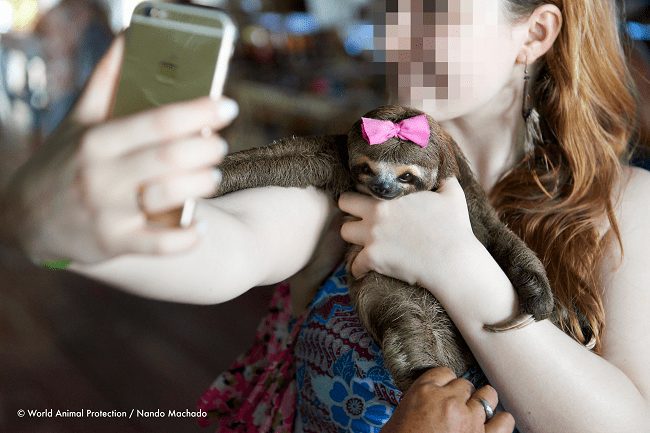The world may have gone selfie mad but, when it comes to wildlife selfies, travellers are being strongly urged to think twice before posting them on social media.
Last week Instagram implemented a new strategy to help curb the harmful habit.
Any Instagram searches for or clicks on hashtags associated with abusive behaviour towards animals by any of its 800 million users will now generate a warning message saying: “You are searching for a hashtag that may be associated with posts that encourage harmful behaviour to animals or the environment.”
The message will include a click-through option to “learn more” which will take users to an information page about wildlife exploitation.
“We encourage you to be mindful of your interactions with wild animals, and consider whether an animal has been smuggled, poached or abused for the sake of tourism,” it says.
“Be wary when paying for photo opportunities with exotic animals, as these photos and videos may put endangered animals at risk.”
Instagram worked with a number of wildlife protection organisations such as the World TRAFFIC, the World Wildlife Fund and World Animal Protection to establish which hashtags were most commonly associated with harmful wildlife selfies.
In October this year, World Animal Protection reported a 292 percent increase in the number of selfies with wild animals posted on Instagram since 2014. More than 40% of these revealed bad interactions with wild animals – specifically someone hugging, holding or inappropriately handling a wild animal.
“We congratulate Instagram on taking this important step towards educating its users about wild animals that are suffering for selfies. The reality is these wild animals are suffering terribly, both in front of and behind the camera,” WAP chief executive Steve McIvor said.
“Wild animals are being taken from their mothers as babies and secretly kept in filthy, cramped conditions or repeatedly baited with food causing severe psychological trauma just so tourists can get photo.”
The charity has launched its own Wildlife Selfie Code for tourists to learn how to take a photo with wild animals without “fueling the cruel wildlife entertainment industry”.
Adventure World is also taking a strong stance on the issue of wildlife selfies, managing director Neil Rodgers told KarryOn.
“We encourage travellers to ensure that they only take selfies with wild animals if they are a safe distance away from the animal when it is in its natural habitat, and that the animal is not captive but is free to move around,” he explained.
“If travellers see animals that are being held, hugged or restrained, baited with food or could possibly harm them, we ask that they don’t take a selfie but instead take note of any animal cruelty they believe is taking place to report to authorities where appropriate.”
Instead, the operator is working hard to ensure its customers leave a positive impact on the destinations they visit.
“As part of Adventure World’s sustainability program, we work with people who, like us, seek to protect the places we explore and who are creating initiatives that are driving positive change,” Rodgers continued.
That includes a partnership with World Animal Protection to provide travellers with “responsible and humane” animal encounters.
It has also pledged not to sell elephant rides or shows in its itineraries, and support’s The Travel Corporation’s TreadRight Foundation which works with Wildlife SOS. The Indian ‘Captive Elephants Welfare Project,’ specifically addresses the problem of injured or sick elephants made to work in “stressful or oppressive” conditions.
Check out Neil’s suggestions on what to look out for when planning a trip which incorporates wildlife experiences:
– Beware of animal rides, as many animals are often poorly fed and not given access to shelter or water
– Animal performances place enormous stress on animals and can involve violent training techniques. It’s unnatural and demeaning for a wild animal to have to ‘perform’ for the sake of entertainment
– Posing for a photo with a wild animal is far from a happy snap. Many of these animals have been taken from the wild and are commonly drugged to control behaviour
– Be sure to book with conscious tour operators who encourage a positive impact in their itineraries and optional activities.
READ: Travel to change the world with Intrepid’s Leigh Barnes
READ: TTC’s boots were made for more than just walking




